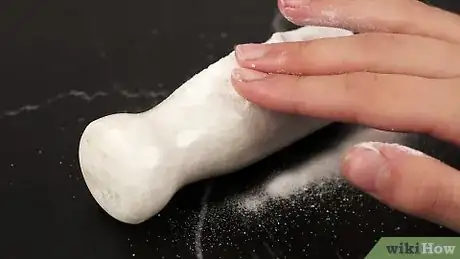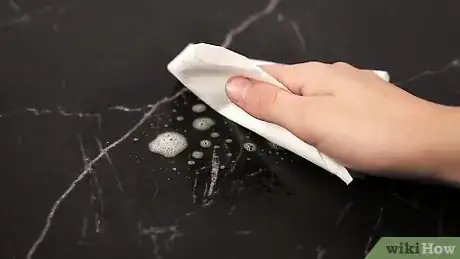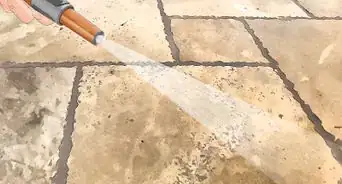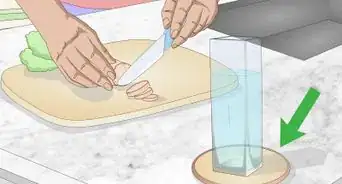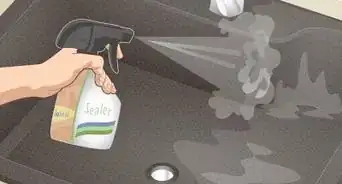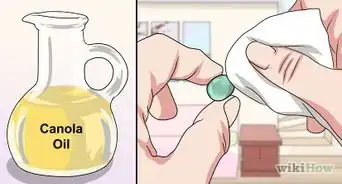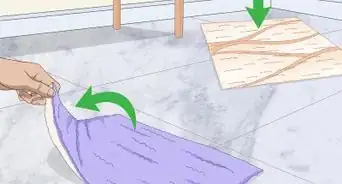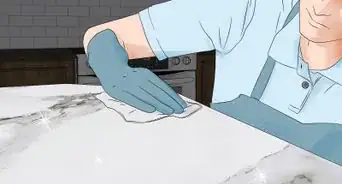This article was co-authored by Chris Willatt and by wikiHow staff writer, Hunter Rising. Chris Willatt is the owner and founder of Alpine Maids, a cleaning agency in Denver, Colorado started in 2015. Alpine Maids has received Angie's List Super Service Award for three years in a row since 2016 and has been awarded Colorado's "Top Rated Local House Cleaning" Award in 2018.
There are 13 references cited in this article, which can be found at the bottom of the page.
wikiHow marks an article as reader-approved once it receives enough positive feedback. In this case, 100% of readers who voted found the article helpful, earning it our reader-approved status.
This article has been viewed 964,598 times.
Do you have marble tiles, floors, or countertops that just don't shine like they used to? Marble is a little more prone to dirt and damage since it's a softer stone, but you can easily maintain it by wiping the surface with a soft cloth and some soapy water or stone cleaner. Before you start washing your marble with anything else at home, there are a few things to keep in mind to keep the surface protected. Keep reading, and we'll walk you through everyday routine cleaning, plus how to get rid of those annoying stains and scratches.
Things You Should Know
- Wipe your marble clean with soapy water every day to get rid of dust, dirt, and grime. Rinse and dry your marble when you’re finished.
- Use a marble cleaner once every week to keep the surface protected and sealed.
- Remove food stains with 12% hydrogen peroxide and ammonia. Lift up oil-based stains with hydrogen peroxide and baking soda.
- Try buffing out minor scratches with polishing compound or 0000 steel wool.
Steps
Daily Upkeep & Cleaning
-
1Clean your marble daily with water and dish soap. Fill a spray bottle with warm water and add in about 1 tablespoon (15 ml) of a mild, non-abrasive dish soap. Just spray an even layer of the soapy water onto the surface, and gently rub it in with a soft microfiber cloth. If your cloth gets dirty with dust or dirt, be sure to rinse it off before wiping with it again.[1]
- If you’re washing a marble floor, then use a larger microfiber mop to spread the soapy water over the surface.
- Soapy water is usually strong enough to eat through soot if you’re cleaning a marble fireplace.
- Avoid using any acidic cleaners, such as lemon juice or vinegar, since they can leave marks on the marble’s surface.
-
2Rinse the soapy water off with a damp cloth. Wet a new non-abrasive cloth with clean water and wipe it over the surface. Lift up as much of the soapy residue as you can so it doesn’t dry onto the marble surface and make it look dull.[2]
- For a marble floor, use a clean mop head or thoroughly wring out the old head before using it to rinse.
Advertisement -
3Dry the marble surface with a microfiber towel. Go over the surface one more time with your dry towel so there aren’t any water spots left over.[3] Run your fingers over the surface to check if the marble still feels wet or if you’ve dried it completely.[4]
- Any water you leave on your marble could absorb into the stone and leave a stain on the surface.
-
4Swap out dish soap for commercial marble cleaner once a week. Spray an even layer of your marble cleaner directly onto the surface. Use a clean microfiber cloth or paper towel to rub the cleaner into your marble. Use the cleaner at least once a week to help the marble retain its shine and to prevent anything on the surface from leaving a stain.[5]
- Always follow the directions on the cleaner’s packaging since they may vary.
- Avoid using other household cleaners like bleach or mineral spirits since they could further damage your marble.
Stain Removal
-
1Treat organic stains with 12% hydrogen peroxide and ammonia. To clean marble countertops with coffee, tea, or food stains, wet the surface of the stain with your hydrogen peroxide used for hair bleaching and add in a couple of drops of ammonia. Gently work the solution into the stain with a microfiber cloth until you see it start to lift up.[6]
- Try to clean up the stain as soon as they happen since they haven’t set in and will be easier to clean up.
- Ammonia is safe to mix with hydrogen peroxide but avoid using it with bleach or any other cleaners since it could create toxic fumes.
-
2Remove oil stains with hydrogen peroxide and baking soda paste. If your stain is from grease, cooking oil, or cosmetics, then mix together equal amounts of hydrogen peroxide and baking soda until they form a thick paste. Apply the paste over the oil stain and let it dry out overnight. The next day, use a plastic putty knife to scrape the dried paste off the marble to remove the stain.[7]
- The baking soda and peroxide will help draw the stain out from the stone and lighten the section of marble.
- Test the baking soda and peroxide mixture on a discreet area of the marble first to make sure it doesn’t leave any marks or damage.
-
3Use a poultice made with rust remover to clean up rust stains. Mix equal parts of your poultice powder and your rust remover so it forms a thick paste.[8] Apply the poultice to the rust stain so it’s completely covered, and let it dry out overnight. The next day, just use a putty knife or clean towel to break apart the poultice.[9]
- If you can still see a rust stain, you can try applying another poultice to your marble. If the stain persists, then it may be permanent on the surface.
-
4Clean off etch marks with a marble polishing powder. Etch marks are when acids eat through the stone and leave discolored marks on the surface. Sprinkle a bit of the marble polishing powder onto the surface with your etch marks. Wet the corner of a soft microfiber and rub the powder into the stone in a circular motion. Keep rubbing the powder in until the etch mark disappears and the marble shines.[10]
Scratch Removal
-
1Try using a polishing compound for minor scratches and nicks. Get the scratches out of your marble by sprinkling the polishing compound directly onto the surface. Use a damp microfiber cloth to rub the compound into the marble using circular movements. Once the marble has a shiny, smooth appearance, wipe the rest of the powder off of the surface.[11]
- You can also use a rotary buffer to apply the polishing powder more quickly on larger surfaces, like a large tabletop or marble floor.
-
2Buff surface scratches out with 0000 steel wool. Keep the steel wool dry so you don’t damage your countertops. Lightly rub the steel wool over the surface with gentle pressure so the smaller scratches disappear. Lift up the steel wool and check the surface periodically to check that the scratches are gone so you don’t put in more work than you need to.[12]
- Some marble manufacturers don’t recommend using steel wool since it’s abrasive and could affect the surface of your marble. Try testing the steel wool in a hidden area of the marble before using it on a scratch.
-
3Contact a marble specialist for deep cracks you can’t remove. If you’re not able to remove the scratch on your own or if there’s a large chip, then it’s better to have a professional try and fix it. Contact local stone specialists or the manufacturer where you got the piece to see what repair services they can offer.[13]
Preventing Damage
-
1
-
2Use coasters and trays for any objects you put on marble surfaces. Rather than putting cups and mugs directly on a marble countertop or table, put a coaster underneath to catch any drops of moisture. If you’ve got a decorative display of toiletry products in a bathroom with marble, use a tray to protect the surface.[16]
- Using coasters prevents glasses or mugs from forming ring-shaped stains on your marble.
-
3
Expert Q&A
Did you know you can get expert answers for this article?
Unlock expert answers by supporting wikiHow
-
QuestionCan I use vinegar to clean marble countertops?
 Chris WillattChris Willatt is the owner and founder of Alpine Maids, a cleaning agency in Denver, Colorado started in 2015. Alpine Maids has received Angie's List Super Service Award for three years in a row since 2016 and has been awarded Colorado's "Top Rated Local House Cleaning" Award in 2018.
Chris WillattChris Willatt is the owner and founder of Alpine Maids, a cleaning agency in Denver, Colorado started in 2015. Alpine Maids has received Angie's List Super Service Award for three years in a row since 2016 and has been awarded Colorado's "Top Rated Local House Cleaning" Award in 2018.
House Cleaning Professional
-
QuestionWhy does marble stain so easily?
 Chris WillattChris Willatt is the owner and founder of Alpine Maids, a cleaning agency in Denver, Colorado started in 2015. Alpine Maids has received Angie's List Super Service Award for three years in a row since 2016 and has been awarded Colorado's "Top Rated Local House Cleaning" Award in 2018.
Chris WillattChris Willatt is the owner and founder of Alpine Maids, a cleaning agency in Denver, Colorado started in 2015. Alpine Maids has received Angie's List Super Service Award for three years in a row since 2016 and has been awarded Colorado's "Top Rated Local House Cleaning" Award in 2018.
House Cleaning Professional
-
QuestionIs marble easy to clean?
 Chris WillattChris Willatt is the owner and founder of Alpine Maids, a cleaning agency in Denver, Colorado started in 2015. Alpine Maids has received Angie's List Super Service Award for three years in a row since 2016 and has been awarded Colorado's "Top Rated Local House Cleaning" Award in 2018.
Chris WillattChris Willatt is the owner and founder of Alpine Maids, a cleaning agency in Denver, Colorado started in 2015. Alpine Maids has received Angie's List Super Service Award for three years in a row since 2016 and has been awarded Colorado's "Top Rated Local House Cleaning" Award in 2018.
House Cleaning Professional
Warnings
- Avoid using any acidic or abrasive cleaners, including vinegar and lemon juice, on your marble since they could leave scratches or unsightly etch marks on the surface.[20]⧼thumbs_response⧽
Things You’ll Need
General Cleaning
Stain Removal
- 12% hydrogen peroxide & ammonia (food stains)
- 12% hydrogen peroxide & baking soda (oil stains)
- Poultice and rust remover (rust stains)
- Polishing powder (etch marks)
Scratch Removal
References
- ↑ https://www.thekitchn.com/how-to-clean-marble-countertops-cleaning-lessons-from-the-kitchn-202955
- ↑ https://go.polycor.com/hubfs/2016/marble-care-guide-polycor.pdf?t=1495658897775
- ↑ Chris Willatt. House Cleaning Professional. Expert Interview. 1 July 2019.
- ↑ https://www.nytimes.com/1985/12/08/nyregion/home-clinic-marble-stained-here-s-how-to-clean-it.html
- ↑ https://www.wbs.com/wp-content/uploads/2020/12/Product-Care-and-Maintenance-Manual_REDUCED_R2020_12-11.pdf
- ↑ https://go.polycor.com/hubfs/2016/marble-care-guide-polycor.pdf?t=1495658897775
- ↑ https://youtu.be/si3qhqduk5A?t=25
- ↑ https://www.nytimes.com/1985/12/08/nyregion/home-clinic-marble-stained-here-s-how-to-clean-it.html
- ↑ https://go.polycor.com/hubfs/2016/marble-care-guide-polycor.pdf?t=1495658897775
- ↑ https://www.naturalstoneinstitute.org/consumers/stains/
- ↑ https://www.mplcompany.net/wp-content/uploads/2020/07/Care-Maintenance-Instructions-for-Cast-Polymer-Cultured-Marble.pdf
- ↑ https://go.polycor.com/hubfs/2016/marble-care-guide-polycor.pdf?t=1495658897775
- ↑ https://static1.squarespace.com/static/59cc15add55b418d5fcbcee5/t/5d35df6f787a6f000167f580/1563811696206/Elite+Care+%26+Maint.pdf
- ↑ Chris Willatt. House Cleaning Professional. Expert Interview. 1 July 2019.
- ↑ https://youtu.be/8fROq6W4il4?t=57
- ↑ https://www.wbs.com/wp-content/uploads/2020/12/Product-Care-and-Maintenance-Manual_REDUCED_R2020_12-11.pdf
- ↑ https://www.millirongq.com/Care-Marble.pdf
- ↑ https://www.millirongq.com/Care-Marble.pdf
- ↑ https://www.millirongq.com/Care-Marble.pdf
- ↑ https://www.millirongq.com/Care-Marble.pdf
About This Article
To clean stained marble, mix baking soda and water until it’s a thick paste. Apply it to the stain and cover it with plastic for 24 hours. Use a damp cloth to wipe away the mixture, repeating the process if the stain is still there. For regular marble maintenance, wipe up spills with a warm, damp cloth and dry it with a cloth. To dust, dampen a cloth with natural, light-colored dish soap and a little warm water, then gently wipe the surface. Follow up by shining the marble with a chamois cloth. To learn how to manage scratches in your marble, keep reading the article!




